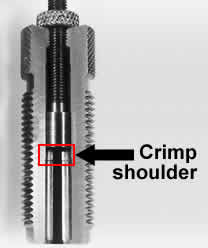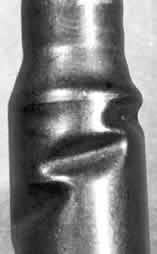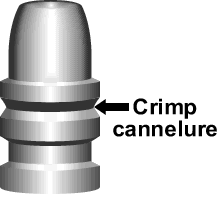- 01: Introduction
- 02: History
- 03: Propellants, Firearms, and Ammunition Development
- 04: Modern Firearms Manufacture
- 05: Small Arms Ammunition
- 06: Evidence Handling Procedures
- 07: Equipment and Instrumentation
- 08: Examination of Firearms
- 09: Cartridge and Shotshell Examination
- 10: Characterization and Evaluation of Fired Projectiles
- 11: Bullet Comparison and Identification
- 12: Gunshot Residue and Distance Determination
- 13: Toolmark Identification
- 14: Communicating Results
- Resources


Crimping
Home > Small Arms Ammunition > Centerfire Ammunition > Crimping
Crimping is the controlled deformation of the cartridge case mouth to strengthen the grip on the bullet.
Crimping
- provides a smoother contour for feeding ammunition (especially in repeating arms),
- prevents bullet set-up during ammunition feeding,
- aids with ignition of the main charge by adding additional friction to retard the bullet as it exits the cartridge case when pressure builds.

Cartridge crimping tool
In centerfire revolver cartridges and some rifle cartridges, crimping is applied by a die with an internal shoulder that rolls the case mouth against the bullet, forming a roll crimp.
The presence or absence of a crimp and the depth to which the crimp is formed are dependent on the type of cartridge. Some cartridges (e.g., 9 mm Luger and .45 Auto) use the case mouth to stop the cartridge from feeding too deeply into the chamber of the firearm. These cartridges are said to headspace on the case mouth. Applying a deep roll crimp to these types of cartridges will likely cause poor accuracy and misfires; they can be successfully loaded without a crimp. However, a very light crimp (barely observable) can smooth handling burrs at the case mount and improve reliability, while providing the required headspace support. This subtle crimp (taper crimp) is applied with a die having a gradually tapered crimping shoulder.
Most factory rifle cartridges and all revolver cartridges receive a substantial crimp at assembly. Revolvers that produce noticeable recoil can cause uncrimped ammunition to lengthen. The effects of inertia during recoil can cause poorly secured bullets to slide forward, possibly causing a malfunction in revolvers. Cartridges can also elongate under heavy recoil in box magazine rifles. In repeating rifles, feeding can force an unsecured (uncrimped) bullet to move too deeply into the case to continue feeding properly.
Roll crimping is common for revolver ammunition; a different system is used for many rifle cartridges, including military cartridges. A roll crimped case is assembled with a crimp shoulder to reinforce placement of the bullet in the mouth of the cartridge case.

Collpased Case
Collet crimping applies force perpendicular to the case axis. A tapered steel tube with partially slit walls, a collet has a step machined on its interior surface that corresponds to the position of the case mouth. The collet moves up and down in a hollow die. As the vertical position of the collet changes, the tapered exterior moves against the support die, forcing the fingers formed by splitting the walls to move inward. This applies pressure to the case mouth where it meets the internal step. Examining the case mouth can identify collet crimping. The crimp area will have short vertical lines between the compressed areas consistent with the number of segments in the collet.

Crimp Cannelure or Recess Location
Taper crimping is the least stressful of the three crimp methods and can be used with any bullet. Roll crimping and collet crimping require that bullets have a recess into which the case mouth can be deflected. Without this, crimping will damage the case and/or the bullet.




